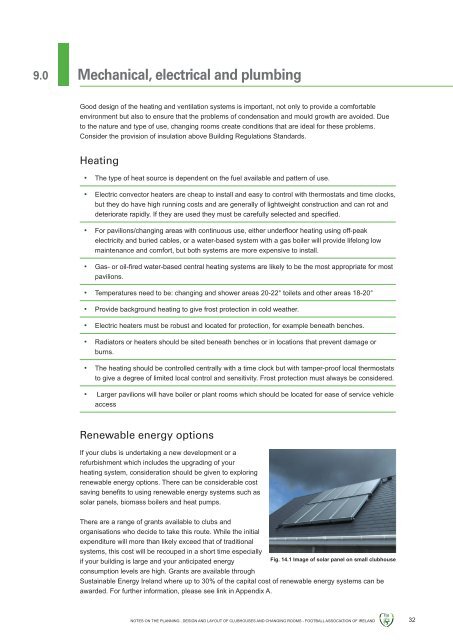Clubhouses & Changing Rooms - FAI
Clubhouses & Changing Rooms - FAI
Clubhouses & Changing Rooms - FAI
Create successful ePaper yourself
Turn your PDF publications into a flip-book with our unique Google optimized e-Paper software.
9.0<br />
Mechanical, electrical and plumbing<br />
Good design of the heating and ventilation systems is important, not only to provide a comfortable<br />
environment but also to ensure that the problems of condensation and mould growth are avoided. due<br />
to the nature and type of use, changing rooms create conditions that are ideal for these problems.<br />
Consider the provision of insulation above building regulations standards.<br />
Heating<br />
• the type of heat source is dependent on the fuel available and pattern of use.<br />
• electric convector heaters are cheap to install and easy to control with thermostats and time clocks,<br />
but they do have high running costs and are generally of lightweight construction and can rot and<br />
deteriorate rapidly. If they are used they must be carefully selected and specified.<br />
• For pavilions/changing areas with continuous use, either underfloor heating using off-peak<br />
electricity and buried cables, or a water-based system with a gas boiler will provide lifelong low<br />
maintenance and comfort, but both systems are more expensive to install.<br />
• Gas- or oil-fired water-based central heating systems are likely to be the most appropriate for most<br />
pavilions.<br />
• temperatures need to be: changing and shower areas 20-22° toilets and other areas 18-20°<br />
• Provide background heating to give frost protection in cold weather.<br />
• electric heaters must be robust and located for protection, for example beneath benches.<br />
• radiators or heaters should be sited beneath benches or in locations that prevent damage or<br />
burns.<br />
• the heating should be controlled centrally with a time clock but with tamper-proof local thermostats<br />
to give a degree of limited local control and sensitivity. frost protection must always be considered.<br />
• larger pavilions will have boiler or plant rooms which should be located for ease of service vehicle<br />
access<br />
Renewable energy options<br />
if your clubs is undertaking a new development or a<br />
refurbishment which includes the upgrading of your<br />
heating system, consideration should be given to exploring<br />
renewable energy options. there can be considerable cost<br />
saving benefits to using renewable energy systems such as<br />
solar panels, biomass boilers and heat pumps.<br />
there are a range of grants available to clubs and<br />
organisations who decide to take this route. While the initial<br />
expenditure will more than likely exceed that of traditional<br />
systems, this cost will be recouped in a short time especially<br />
if your building is large and your anticipated energy<br />
Fig. 14.1 Image of solar panel on small clubhouse<br />
consumption levels are high. Grants are available through<br />
sustainable energy ireland where up to 30% of the capital cost of renewable energy systems can be<br />
awarded. for further information, please see link in appendix a.<br />
notes on the PlanninG , desiGn and laYout of <strong>Clubhouses</strong> and ChanGinG rooms - football assoCiation of ireland<br />
32



